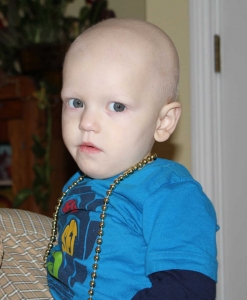Liam Wuenn

Liam Wuenn
One hot summer night, after a long day with two toddlers, I was rocking my baby to sleep. As I was rocking him, I noticed how his shape seemed to fit so perfectly in the contour of my left arm. I thought immediately how God’s creation is truly remarkable. As I pondered in amazement, I began to rub his belly with my other hand, realizing how hard his left abdomen felt yet the right side was soft. I began poking a bit more aggressively recognizing the shape and location. It had to be a solid mass. My baby had a mass!? After 10 years of work in various imaging healthcare departments, potential diagnoses began to flood my mind. I hardly slept that night knowing the next day would be difficult.
The next morning, I had everyone in place. I had arranged for childcare for my daughter, flight plans for Liam’s dad and a friend to meet me in Chicago. I had packed a bag the night before since I wasn’t sleeping anyway. Everyone thought I was overreacting. It was a Saturday morning. I showed up to the pediatrician’s office unannounced, where I had just visited 2 days prior. I was a frequent flier and continued to be told nothing was wrong. I was just an unnecessary worrier. I was so afraid the pediatrician’s office was going to refer me for a mental evaluation if I was wrong. When the pediatrician lay Liam on the exam table, he gave me the questioning look of ‘how was this missed?”. At that point in time, nothing mattered. I was only interested in moving forward. I was provided an imaging order for a CT scan locally, which would be necessary to gain admittance to Lurie Children’s Hospital in Chicago. The doctors seemed to agree with my initial thoughts of Wilms Tumor.
Looking back, I was naïve to just how difficult life would become and what lay ahead. 4 days in the brand new Lurie Children’s Hospital equated to $40,000.00 debt. I had never been in debt quite like that before. Chemotherapy began immediately and on the 4th day Liam went home. Chemotherapy appointments filled our calendar.
Fast forward 6 weeks, the tumor wasn’t responding to chemotherapy. The pediatric surgeon called for immediate surgery to remove the left kidney and tumor. Instead of Wilms tumor, the pathology report revealed malignant rhabdoid tumor of the kidney. At Liam’s age, that meant terminal cancer.
In 2011, the most recent study included only 9 children. All had lost their fight when diagnosed under the age of 1 year. And, of those who made it to 5 years old, there is only a 15-20% survival rate. It is now known that malignant rhabdoid tumors are a progressive form of Wilms tumor that occur most commonly in infants and toddlers. The average age of diagnosis being 15 months old. There are about 20 to 25 new cases of malignant rhabdoid tumor diagnosed each year in the United States. Cells from malignant rhabdoid tumors in children can spread (metastasize) to other areas of the body. In general, malignant rhabdoid tumors are very aggressive and difficult to treat. Patients often initially respond well to treatment, but relapse either during or shortly after treatment. Children with germline mutations such as SMARCB1, which is a tumor suppressor gene, also have a high risk of developing secondary tumors. The SMARCB1 gene, also goes by the names INI1, SNF5 and BAF47, which is turned off in nearly all rhabdoid tumors. (Dana-Farber, Boston).
Liam did have the SMARCB1 germline mutation. Thankfully, Liam’s dad, myself and Liam’s sibling did not possess this mutation. Liam’s battle was just short of 6 months from diagnosis. He earned his wings at the young age of 14 months.
Liam’s death was devastating. We will grieve forever because the death of a child is unnatural-backwards. Knowing his memory lives on through the families we continue to help within other charitable organizations, eases the pain. Our greatest hope is that this disease will one day be eradicated and no other family will suffer such loss.
Further information about MRT:
https://www.ncbi.nlm.nih.gov/pmc/articles/PM
https://www.sciencedirect.com/science/article/pii/S0923753419518725
https://www.dana-farber.org/childhood-malignant-rhabdoid-tumor/ames
Liam Wuenn

One hot summer night, after a long day with two toddlers, I was rocking my baby to sleep. As I was rocking him, I noticed how his shape seemed to fit so perfectly in the contour of my left arm. I thought immediately how God’s creation is truly remarkable. As I pondered in amazement, I began to rub his belly with my other hand, realizing how hard his left abdomen felt yet the right side was soft. I began poking a bit more aggressively recognizing the shape and location. It had to be a solid mass. My baby had a mass!? After 10 years of work in various imaging healthcare departments, potential diagnoses began to flood my mind. I hardly slept that night knowing the next day would be difficult.
The next morning, I had everyone in place. I had arranged for childcare for my daughter, flight plans for Liam’s dad and a friend to meet me in Chicago. I had packed a bag the night before since I wasn’t sleeping anyway. Everyone thought I was overreacting. It was a Saturday morning. I showed up to the pediatrician’s office unannounced, where I had just visited 2 days prior. I was a frequent flier and continued to be told nothing was wrong. I was just an unnecessary worrier. I was so afraid the pediatrician’s office was going to refer me for a mental evaluation if I was wrong. When the pediatrician lay Liam on the exam table, he gave me the questioning look of ‘how was this missed?”. At that point in time, nothing mattered. I was only interested in moving forward. I was provided an imaging order for a CT scan locally, which would be necessary to gain admittance to Lurie Children’s Hospital in Chicago. The doctors seemed to agree with my initial thoughts of Wilms Tumor.
Looking back, I was naïve to just how difficult life would become and what lay ahead. 4 days in the brand new Lurie Children’s Hospital equated to $40,000.00 debt. I had never been in debt quite like that before. Chemotherapy began immediately and on the 4th day Liam went home. Chemotherapy appointments filled our calendar.
Fast forward 6 weeks, the tumor wasn’t responding to chemotherapy. The pediatric surgeon called for immediate surgery to remove the left kidney and tumor. Instead of Wilms tumor, the pathology report revealed malignant rhabdoid tumor of the kidney. At Liam’s age, that meant terminal cancer.
In 2011, the most recent study included only 9 children. All had lost their fight when diagnosed under the age of 1 year. And, of those who made it to 5 years old, there is only a 15-20% survival rate. It is now known that malignant rhabdoid tumors are a progressive form of Wilms tumor that occur most commonly in infants and toddlers. The average age of diagnosis being 15 months old. There are about 20 to 25 new cases of malignant rhabdoid tumor diagnosed each year in the United States. Cells from malignant rhabdoid tumors in children can spread (metastasize) to other areas of the body. In general, malignant rhabdoid tumors are very aggressive and difficult to treat. Patients often initially respond well to treatment, but relapse either during or shortly after treatment. Children with germline mutations such as SMARCB1, which is a tumor suppressor gene, also have a high risk of developing secondary tumors. The SMARCB1 gene, also goes by the names INI1, SNF5 and BAF47, which is turned off in nearly all rhabdoid tumors. (Dana-Farber, Boston).
Liam did have the SMARCB1 germline mutation. Thankfully, Liam’s dad, myself and Liam’s sibling did not possess this mutation. Liam’s battle was just short of 6 months from diagnosis. He earned his wings at the young age of 14 months.
Liam’s death was devastating. We will grieve forever because the death of a child is unnatural-backwards. Knowing his memory lives on through the families we continue to help within other charitable organizations, eases the pain. Our greatest hope is that this disease will one day be eradicated and no other family will suffer such loss.
Further information about MRT:
https://www.ncbi.nlm.nih.gov/pmc/articles/PM
https://www.sciencedirect.com/science/article/pii/S0923753419518725
https://www.dana-farber.org/childhood-malignant-rhabdoid-tumor/ames
